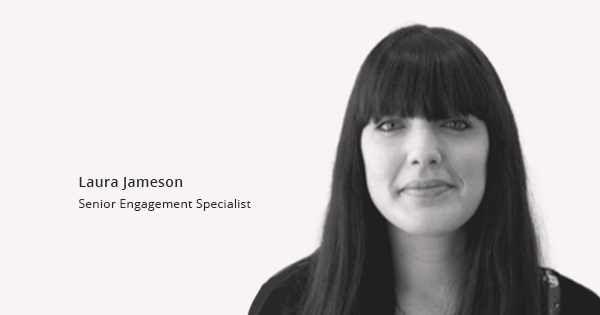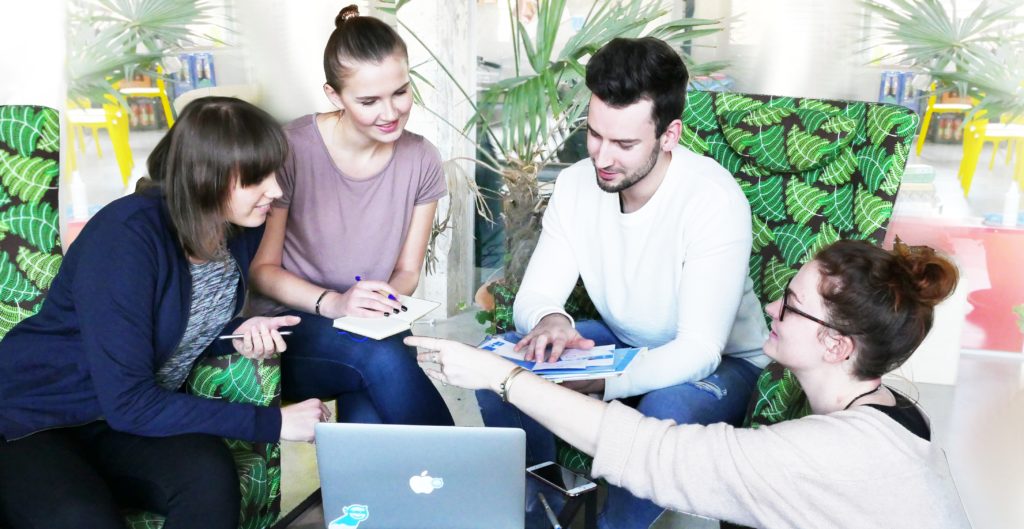3 Ways to Unleash Your Internal Influencers to Produce Results

Internal influencers are a VIP part of your communications strategy to engage employees and drive change at work. Here are 3 ways that internal influencers can help you make a difference and produce results in your organization for happy leaders and employees.
Hear from Award-Winning Senior Engagement Specialist Laura Jameson from Instinctif Partners who shares examples from internal influencer networks that have made a crucial difference for big companies during times of change!
Carla: Thank you all for being here for another webinar with Staffbase. And welcome to our friend from Instinctif Partners, Laura Jameson. Laura is an award-winning senior engagement specialist, and she is here to tell us what we need to know about internal influencers, who they are, how to find them, and what they can do for your organization. Laura has worked with companies around the world, some big well-known brands to help them identify their internal influencers and to show them what they can do to make a difference at work. Laura, thank you so much for joining us today, and thank you for presenting to our audience of communicators.

And we create that experience with an approach built on the premise of movements. In its simplest form, a movement is a group of people that work together to advance their shared political, social, or artistic goals, and they do it very, very fast. It’s usually formed by one or two people who focus on getting others behind their cause, and they create a space and opportunity for collaboration and discussion around a really hot topic. That’s all well and good in an external environment, but starting movements in a large organization is never easy. And so we recognize that in order to do that, you need the technique or the principle to be able to first identify those influencers, who they are in an organization, why they are, and how you can use them to help kick-start some of those movements.
The Definition of Internal Influencers
That’s a little bit of the theory. But when we say influencer, what do we mean? And more importantly, how does that differ from some more of the traditionally used champions or brand ambassadors that we see used on a day to day basis?
“Champions and ambassadors are often self-nominated, whereas influencers are peer-nominated, which is why they have this gravitas to spark movements and start to drive change more efficiently.
For the most part, champions and ambassadors tend to be the most high performing individuals within an organization, whereas your influencers come and sometimes do include unengaged employees, potentially disruptive employees, and cynics. But essentially, they are people that have a really strong voice and they have an ear to the ground and really can help you drive change. And by listening to them and using them as a sounding board for your programs or a test case for potential engagement programs, you can really tap into their knowledge and surface any potential issues or barriers to success really quickly. And finally, influence networks aren’t necessarily official. So we tend to see champion ambassador programs launched with a big fanfare. You know, they wear the champion badge almost as like a medal of honor. But the influence in that where it tends to operate slightly under the radar and it’s a much more subtle tool to use to really start to get under the skin of certain campaigns.
Why do we think influencers are important in an organization? I mentioned before that one of the principles that we have talked about and also that I’ve certainly seen in my career is how the role of influencers in the external media has dramatically changed. Influencers can have a really, really profound impact on the campaign and for many brands, influence is now a key tool in any marketing armory.
Here are a few facts and figures for you. In 2017, brands spent $1,000,000,000 on influencer marketing on Instagram alone. And this is expected to have doubled by 2019. And if we look up top 10 influencers on Instagram, their combined reach is over 1.1 billion followers. Collectively, they can earn $6.8 million for a single post. So the reach in this sort of environment is absolutely phenomenal. And we’re starting to see agency landscape’s change to really harness that. So agencies exist solely to march brands to influencers that will help them reach their key demographics. And that was certainly something that didn’t happen 5 or 10 years ago. So it’s a growing phenomena and a growing trend and we certainly expect to see it continue to rise.
How to Find and Engage Your Internal Influencers
But when it comes to internal communications in the absence of an agency or the platforms such as Instagram that can help you identify your company’s version of Kylie Jenner, how can we find them and how can we engage them in the right way?
1. Snowball Sampling – We tend to use a principle called snowball sampling to identify influencers. And snowball sampling is based on the idea of crowdsourcing. So how do you find those people, those influencers within an organization, that can help build groundswell and help really get that reach throughout your organization? Snowball sampling itself is actually a technique that was developed by McKinsey&Company.
Those of you that don’t know it, it was a program that was used to engage sex workers around health education in San Francisco. So this was a traditional group that was reluctant to participate in any surveys or engage with authority figures. And rather than try to engage the whole community with blanket marketing, the technique that they used was to ask people to instead identify friends and people within their networks to take part in a short survey. And what they found was that the same names came up time and time again, indicating that these individuals were really highly connected across the community and they were the real audience for communication. And if they could reach those people, you know, 50 to 100 people that connected to the rest of the community, they found that this method created much, much more positive change in a shorter period of time.
And that is a principle that you can apply in a corporate environment. You can get your people to answer quick, simple questions. Who do they trust? Who do they look up to or aspire to? And who would they go to if they had a question? As the names are put forward, you will find that certain names appear more frequently and those people are your influencers within your business. And this group can be used in a number of different ways. They can be used to focus on driving an agenda forward regardless of what that may be. As I mentioned previously, they can be a test ground for an approach. And they can be really, really influential and be perceived differently than a champion now within your organization and really start to have that effect behind the scenes.

2. A Common Cause – Finding them alone is not enough. Once you know who your influencers are, how do you engage them and how do you bring them together and unite them behind a common cause? I often find that the best way to demonstrate a theory is to show it in practice. So what we want to do now is talk you through a few examples that we have on how we’ve helped some of our clients recruit and empower their influencers to support on a wide range of campaigns.
Our first example looks at a global pharmaceutical company with over 20,000 employees worldwide. The UK arm of this company focuses on R&D and innovation and has teams based across a number of key sites, making engagement and connectivity quite difficult. And this was then reflected in quite low engagement scores across their employee engagement survey. They came to us with a very clear ambition. They wanted to be listed as a “Sunday Times” best place to work by 2019. To help them achieve this vision, the business had already created a strategy and a program which was aimed at helping them create a better place to work.
But the program itself along with a narrative and a vision of identity doesn’t guarantee success with internal campaign, especially when you’re operating in an environment that’s quite segmented with notably low engagement. And what the business really needed to understand was what needed to change to make the principles behind the program become a reality? So we worked with them to launch recruitment campaigns for their connectors. And this was an influencer network from all levels of the business who could help deliver the program. Through a very visual recruitment campaign, we received over 230 nominations, took forward just over a hundred to form our community. And this was a group who’s responsibility was to help us drive forward the delivery of the program.
Through this peer-nominated recruitment program, these individuals were selected on their ability to energize teams, get things done, solve problems, or just generally be a good communicator. Once they were recruited, these connectors helped us build a community that were involved in rolling out the program alongside their senior leaders. So they were actively involved in communicating it to other colleagues across the business. They helped us develop and drive the connect strategy, so they were really empowered to shape it as they saw fit. And we also used them as our ears on the ground. We helped to establish a two-way dialogue. The connectors were able to feedback opinions from their local teams so that the program itself really did reflect a cross-section of employees.
“And through this peer-nominated recruitment program, these individuals were selected on their ability to energize teams, get things done, solve problems, or just generally be a good communicator.”
Another example to show you is some work that we did with one of the largest insurers in the UK. These guys have around 10,000 employees across a number of very, very disparate sites. And this company has a very clear ambition to become a true partner to your customers and that intention also extends to its people. So they really needed a way for their people’s voices to be heard and feel more involved in the company-wide strategy. So we worked with them again to identify and establish their influencers group, a group of credible people across the business who were well respected, influential, who role-modeled certain values, and could represent the views of the wider employee base.
Again, to identify these influencers, we developed a thought-provoking internal campaign, asked for colleagues to nominate peers demonstrating key skills and traits that aligned to the values. In total, we had over 1,400 nominations and the selection and process resulted in 60 influencers being chosen at all levels of the business with varying levels of service. So we really did have a truly representative group from across the business. And to engage these influencers directly, we then designed a series of interactive sessions which saw them come together with senior leaders including the CEO for a working session. That session allowed them to tackle key business challenges, whether that was around internal decision making or simplification of processes, and really make sure that these influencers experienced the way of working, that meant their voices and opinions were truly heard.
The creation of this influencer network has allowed the company really to get closer to the employee voice. It’s also actually helped to develop a new dialogue channel for senior leaders, which has increased their visibility and ability to connect with employees and promote a culture of openness, something that we know from many, many conversations with our clients is a really, really big barrier for communications internally. That first influencer session resulted in fantastic ideas being generated to improve ways of working across the business. And actually, one of these ideas was taken on board, and championed by the CEO and has now been implemented across the organization.
3. An Inner Circle – The final example we wanted to talk to you about was the work that we did with a global information services provider, again, identifying an influencer network to help them galvanize over 50,000 people worldwide behind the company strategy. Using our approach, they looked for people with qualities that they had identified where they needed to get things done and were experts in thinking like consumers, people who were great communicators, very vocal, and likely to spread their knowledge amongst their networks.
And these influencers through a series of different activations in a number of different conversations and interactions with them became our trusted advisors when we came to planning and implementing this campaign, almost a bit of an inner circle. And we gave them advanced access and insight to planned communications, we got them involved in shaping engagement approaches for strategy. The overall feedback that we had from them was that they felt that they had a voice and a say in how the company connected with its employees on what was essentially a very important matter. Creating this inner circle with our influencers helped us build one of their most successful internal campaigns that really truly connected employees in a different way, but got people across the business not just talking about doing things differently, but in a way that was endorsed and spearheaded by leaders and peers, the people that they really connected with.
These programs saw more than 33% of workforce participation in person with another 37% doing this virtually, and 49% of their offices worldwide hosted live events in over 150 locations, all of that powered by the force of the influencer network that we have established. And to this date, 75% of our influencers were also campaign ambassadors on the day and they’re continuing to be involved with the program almost three years later. So they’re still out there, they’re still driving change and creating a community that helps to solve and overcome barriers, no matter what the problem.

Laura: So those are a few practical examples. I think what we’ve found from the work that we’ve done and the conversations that we have with our clients is that there are three key things that you need to take away when it comes to implementing influencer networks within your organization. First of all, it’s about crowdsourcing the real influencers. So not your traditional champion ambassadors, but the people that really hold sway within your organization. And think about how you find them. Crowdsourcing, snowball sampling, even just through one to one conversations about who is the person in their particular team or a particular function. But it’s about understanding your organization and really getting under the skin of it and knowing who best to go to.
Once you’ve identified them, you need to involve them. So shaping and owning how you go about engaging the rest of the people. These groups of influencers as we’ve talked about will be incredibly vocal, quite cynical. And if you don’t involve them in the process and get them excited about what you’re doing, they can and do have the ability to really sidetrack a project. If they’re not advocates of it, they can really derail things. And also the great way of doing that is about giving them the inside track, so advanced access to information and using them as your test beds for particular projects or particular campaigns and keeping a dialog open with them as you go through that process really helps to keep them on board.
I think there’s also three other principles that we need to, as communicators, understand that if we’re gonna use an influencer network, what are the things that we need to be willing to do ourselves? So as I’ve mentioned, the two-way dialogue and the access to information is something that if we’re gonna do it, we have to be willing to take on board that feedback. So co-creation and collaboration with that network is incredibly important. Don’t just give them the access, take the insight, and don’t do anything with it. Being open and honest with them and also being prepared to hear that openness and honest feedback. So they will tell you if they don’t agree with a certain approach or they don’t feel a campaign will land right. You have to be willing and ready to respond to that feedback and act accordingly.
And keep the commands of conversation open. You need to be ready to listen and make changes and you can’t do that unless you’re prepared to do something to respond to what you hear. Keep those lines of conversation open even beyond the initial campaign phase. Or if it’s just a single program that you’re using those influencers for, keep that dialog open with them because they can also be the group that gives you the on-the-ground feedback for how a campaign’s landing or the sentiment that you see within certain groups at a particular time. Keep that dialog going with them and you will really be able to harness the power of the influencer network.
Carla: Thank you, Laura. I think that was very insightful about the role that internal influencers can play. And also I found the difference between the champions or brand ambassadors or advocates versus internal influencers very interesting. I think that those terms are used similarly sometimes, but it’s really interesting to see how their roles are different and how the outcome can be different in the things that they provide for an organization. If anybody has a question, please feel free to chat here for Laura. Otherwise, Laura, what are some top questions that you get from the clients that you work with about internal influencers.
Laura: I think the first step before you even start to think about recruiting your influencers is understanding whether as an organization, you’re ready for it. You have to be culturally ready to have an open conversation with employees, even if that dialog’s not particularly palatable. Networks do particularly well in quite complex global organizations with disparate audiences because they are a great catalyst for bringing people together. So it’s about understanding, you know, what dynamic is gonna fit with your business. Do you have the right networks to be able to go out and engage people in that way? And are you willing and ready to take on board what that group has to say? And I think that before you start any recruitment campaign, there are a couple of questions that you need to ask yourself as to whether this is the right way to go.
I think another question that we tend to get is around optimal size. I think as you will have seen from the three examples that we gave, there was a wide range from companies with employees in the double figures almost to triple digits. The answer is that there is no ideal size. It completely depends on the type of organization you work for and the business challenge that you’re trying to address. Some organizations really need a strong global representation or there’s need to think about engagement and change in particular business units.
You really need to think about what your challenge is that you’re trying to solve and what you think is an optimal number to really help you do that based on your audience size and your reach in your footprint. I think representation is always something that gets brought up as well. You know, not just numbers but cross sections. So again, there’s not a one size fits all. You need to work to what you’re trying to achieve and think about where the change needs to happen within the business to make sure that you’ve got the right people in the right roles, helping you do that.
Carla: Got it. I think there’s a question there in the chat, Laura.
Laura: Okay. What do you do if people want to be influencers, but you don’t think they will be any good? We have a few quality controls that we encourage our clients to have in place. So as I mentioned, purely by the way that you engage through this process, you can and often do come across names and individuals that might be very cynical or might be quite unengaged, potentially quite disruptive. And I think there are a few things that you need to just be mindful of when engaging with that group. I think a simple conversation with HR to understand any underlying issues that might be at stake is always a really, really good principle to apply.
I don’t think that it starts with kind of performance issues. If these names are coming up time and time again, I think they are influencers. What you potentially also need to be mindful of is the role that you give them. So if they’ve got a voice, how do you best use it? And it might be that in a group of 60, 70 people, you know that you’ve got 30 really good communicators who can go and deliver a message for you really well. But then the other 40 might have better skills that can be used in other ways. If you’re running an event, for example, it might be that you get them involved in the facilitation piece on that side of things. Do your quality control but also understand who that group is and place their strengths and give them roles and responsibilities accordingly.
Carla: Got it. There’s another one for you. How can an organization best measure the power of influencers?
Laura: That’s a really good question. Again, it kind of comes back to what’s the problem you’re trying to solve. There are no hard and fast measures, but it’s about being really clear about what you are tasking your influencers to do. Are you looking to improve scores on a particular element of your engagement survey? Are you looking to embed a particular change process or a particular strategy roll out and take that as your guide? I think there are ways and means of looking at voice shared within organizations and all of that sort of thing, but it really does come down to what the objectives of that group are.
And I think measurement is a really important point. Don’t just identify this group. As you engage them, as you bring them on board for a program or get them involved in a certain activity, be really clear with them about what you need them to do. That’s a principle that applies for both influencers and for any champion or ambassador program. If you don’t give them direction and you don’t give them tasks and things that you need them to achieve, it’s really difficult to measure how successful they are.
Carla: I feel like measurement is a continual challenge for all of us. I also like the point about being very clear about your objective and your challenge and your project for your network.
Laura: Yeah, absolutely. I think it is down to the individual remit of what you’re trying to achieve and making sure that you are recruiting for purpose. I kind of watch out when it comes to building these networks is that you don’t want them to become another communications channel once they have completed their project. When you start to see momentum and success as a result of engaging in influence population, you can so easily start to take that next step and use them only as a communications channel if you don’t continue to engage them in the right way. They are not a mouthpiece. They’re influencers, and they’re influencers for a reason. Keep them engaged, keep using them in the right way, and they will continue to help you succeed on whatever it is that you’re trying to do.
Carla: Keep them happy and listen to them constantly, right? It’s like the two-way street you talked about.
Laura: Exactly. Exactly.
Carla: That’s awesome. If anybody here is using an internal influencers network, I would love it if you could chat here and maybe even just share any stories about how that has worked for you and your organization. Otherwise, are there any other questions before we wrap up here?
One more thing for you, Laura. Internal communicators, specifically, I think a lot of times when they come to Staffbase, they’re looking for solutions during times of change. With all of your clients, have you seen, you know, during periods of heavy growth or other types of change, have you seen internal influencers make a real difference and how does that work?
Laura: Yeah, I mean 9 times out of 10, when we work with clients to build influencer networks, it’s because they’re going through those changes or, you know, they have a real business objective that they are trying to achieve. So the global information services provider that I referred to, they were completely revamping their entire business strategy. And that network of influencers, as I mentioned, helped to turn it into one of their most successful internal campaigns. It’s something that they now, they continue to do on a regular basis because that network is people really helped land that campaign or that strategy within the business. So if I’m being honest, I think if you’re going through some heavy period of change, it’s very, very wise to look at building an influencer network and having them as part of your armory to deliver that successfully.
Carla: Great. Thank you for your insights. It has been wonderful to hear. And like you said, Laura, it’s such a trendy topic. I know you have been working with clients with internal influencers for a couple of years and you’ve seen an increase lately. At Staffbase, we have heard about internal influencers and how you can use our employee app to locate those individuals and can show you how to use them as content contributors.
We’re very thankful to have worked with you, Laura, and your team at Instinctif Partners. You’re doing awesome work across the board, and we hope that all of our participants today will join us again for another webinar soon.









